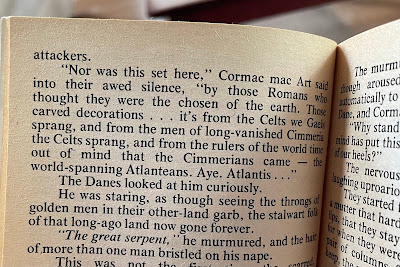I’m a busy dude. I imagine most men and women with adult commitments are too, so no excuses.
But this past 10 days has seen me fly to Texas for a company retreat, then from there fly straight to Rhode Island for a guy’s weekend. Then back to a busy work schedule Monday, helping out my ailing Dad with a few things, and I leave tonight on a flight to Tennessee. It’s not easy being me … but in all honesty my liver and my sanity are paying the price.
That has left me no time for blogging. Which sounds like a small price to pay, but when I don’t write here I start getting a bit twitchy. Blogging about all things fantastic provides me some creative outlet that I can’t quite articulate, just that it exists, and I feel its absence acutely.
So here’s a few interesting items to tide me over until I can write something more substantial.
1. My friend Ken Lizzi has a new S&S novel out, Cesar the Bravo. I’ve known Ken mainly through online interactions but got to spend some time with him in Cross Plains TX in 2023 for Robert E. Howard Days. We spoke on a pirate S&S panel together and drank Shiner Bock while watching Master and Commander. Support S&S, support contemporary authors doing good work, and check out Ken’s book. Bravo, Ken (#dadjoke). Learn more here or order on Amazon. BTW you should follow Ken's blog.
2. I continue to work on my heavy metal memoir. I’ve shown it to a few friends and gotten some good feedback. I also sent it or pieces of it to a handful of specialty publishers back in June and was met with deafening silence, so that means in all likelihood it will be self-published. I’m more than good with this; traditional publishing is, with some exceptions, a losing proposition. Writing is brutally hard, and when you’re done with agonizing draft after draft and self-doubt and the realization that you suck as a writer but you keep going and grinding and finally have something readable, the work is just beginning. Because you have to be found in a sea of other books, millions of which are being published in a year. Marketing is the hard part and publishers don’t do this; it’s on the author. Which I will do. I’m sure the memoir will sink beneath the waves after I publish it, but that’s not why I am writing it. I literally need to write this, and I’m pretty happy with how its shaping up.
3. Carl Jung is the man. I am working my way through Man and His Symbols, which is generally accorded his most accessible work. It’s an odd book; only the first section is his, the rest is written by Jungian disciples/believers or whatever term you want to apply. But his stuff is, to risk hyperbole and hero-worship, a bit of genius. Here’s a few choice quotes; I’ve been writing them down feverishly as I read:
***
It is true, however, that in recent times civilized man has acquired a certain amount of will power, which he can apply where he pleases. He has learned to do his work efficiently without having recourse to chanting and drumming to hypnotize him into the state of doing. He can even dispense with a daily prayer for divine aid. He can carry out what he proposes to do, and he can apparently translate his ideas into action without a hitch, whereas the primitive seems to be hampered at each step by fears, superstitions, and other unseen obstacles to action. The motto “Where there’s a will, there’s a way” is the superstition of modern man. Yet in order to sustain his creed, contemporary man pays the price in a remarkable lack of introspection. He is blind to the fact that, with all his rationality and efficiency, he is possessed by “powers” that are beyond his control. His gods and demons have not disappeared at all; they have merely got new names. They keep him on the run with restlessness, vague apprehensions, psychological complications, an insatiable need for pills, alcohol, tobacco, food—and, above all, a large array of neuroses.
***
A man likes to believe that he is the master of his soul. But as long as he is unable to control his moods and emotions, or to be conscious of the myriad secret ways in which unconscious factors insinuate themselves into his arrangements and decisions, he is certainly not his own master.
***
But all such attempts have proven singularly ineffective, and will do so as long as we try to convince ourselves and the world that it is only they (i.e., our opponents) who are wrong. It would be much more to the point for us to make a serious attempt to recognize our own shadow and its nefarious doings. If we could see our shadow (the dark side of our nature), we should be immune to any moral and mental infection and insinuation.

























